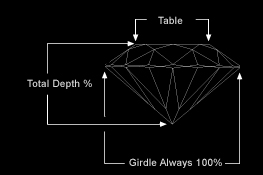Design
Throughout history design has played a great role in society. From beauty to rebellion, design has reflected the emotions and opinions of the people. Design is not static. Design is fluid, existing in a constant state of change. As we see the evolving and often revolving nature of all design, jewelry is poised at the top of our personal expression. The most enduring design must incorporate an element of simplicity and style. A beautiful piece of jewelry that is not comfortable will seldom be worn. When it comes to design, take a little risk, but select the jewelry that will exemplify your lifestyle and personality.
Gold
Sought after by explorers, this element is the most widely desired metal in modern jewelry manufacturing. Gold, whose atomic symbol is Au on the periodic table of elements, is naturally yellow in color. The specific gravity of gold is 19.3+, which is quite heavy for metallic minerals. One quality of gold is that it is easily formed into various shapes. This has made it a premium choice for jewelry artisans throughout the centuries. Gold in its purest form is defined as 24 karat. Pure gold is too soft for most jewelry uses, so it is mixed, or alloyed, with other metals to alter its properties and color. It is common to see gold jewelry in 18k or 14k. This represents an alloy that contains 18/24 or 14/24 parts gold in the overall mix. This value could also be expressed in percentages of purity as 75% for 18k and 58.33% for 14k.
Platinum
Platinum, whose atomic symbol is Pt on the periodic table of elements, is naturally gray, or silver in color. The specific gravity of platinum is 21.5, which is heavier than gold. Platinum for jewelry, as opposed to gold, is used in a nearly pure alloy, which makes for a much heavier piece than the same design made in gold. Platinum is easily formed into various shapes, and it is usually mixed, or alloyed, with other metals such as gold, nickel, iridium, palladium, rhodium, or ruthenium to alter its properties. Platinum will cost approximately 2-4 times as much as the same piece of jewelry made in gold. This is due to the density of platinum as well as the extreme heat and techniques required for its manufacture.
Care
Although diamonds are the hardest known substance, it is possible to damage them without proper care.
Storage – It is best to store your diamond jewelry separately. We suggest individual jewelry cases, cloth pouches, or a fabric-lined jewelry box with separate dividers and compartments. Your diamonds and jewelry may become scratched or damaged when not stored properly and when allowed to contact other jewelry.
Cleaning – Lotions, soaps, powders, perfumes, and hair spray are great hindrances to beautiful and sparkling jewelry. Be sure your skin is free from these or other products prior to putting on your jewelry. From time to time you may want to clean your diamond jewelry at home. Contrary to popular belief, toothpaste is not recommended. The abrasives present in toothpaste will subtly dull the metal of your setting.
It is best to prepare a solution of 1 part ammonia (or Mr. Clean) to 4 parts warm water. Add a small amount of a mild liquid dishwashing soap. Let your jewelry soak for approximately 10 minutes. Scrub the jewelry gently with a new soft toothbrush that you will use for jewelry cleaning only. Dip the jewelry in the solution repeatedly then rinse under warm-hot tap water. Pat the jewelry dry with a lint-free cloth.
Extended Care – Jewelry should not be worn while participating in sporting activities or heavy labor. Diamonds may be chipped by a hard impact. Jewelry may be damaged or broken during strenuous activities. Do not allow your gold jewelry to come in contact with harsh chemicals such as chlorine and bleach. Remove your jewelry prior to entering a swimming pool or hot tub. Repeated exposure to even small amounts of these chemicals has a cumulative effect, causing gold to become brittle and susceptible to breaks and prong failure.
Inspection – Have your jewelry professionally inspected at least once a year. Your jewelry should be checked for loose stones, bent prongs, or signs of wear. It is a good idea to have your jewelry professionally cleaned at the time of inspection.



